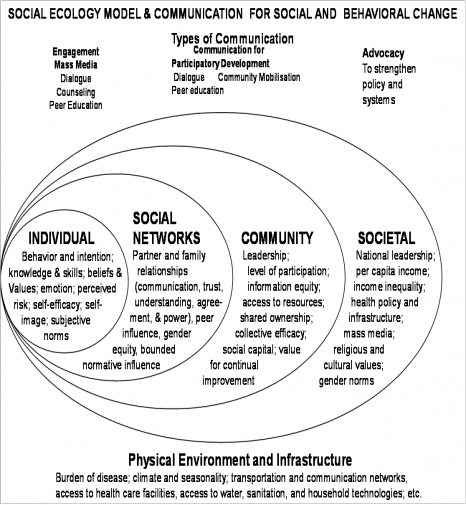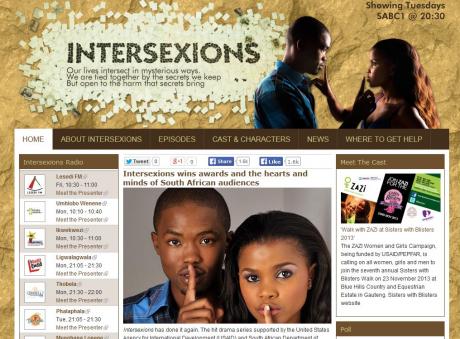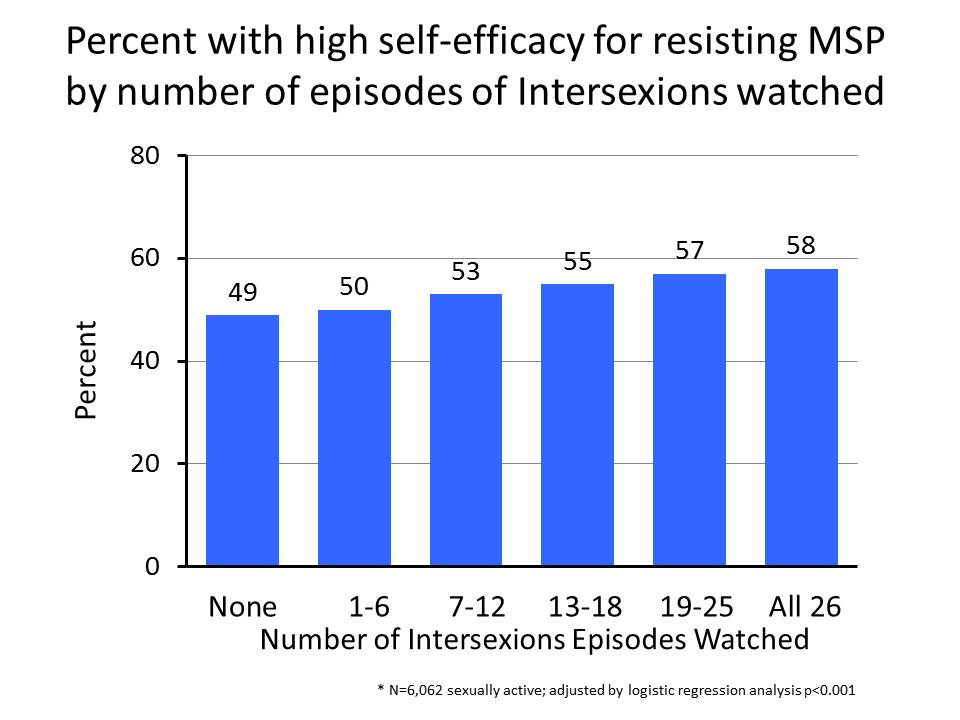Intersexions is an award-winning television series that shows how the inter-relationships between sexual partners enable HIV to spread insidiously across society. Episode by episode, Intersexions systematically fills in another link in the sexual network which spreads and doubles back on itself, introducing new characters and occasionally revisiting familiar ones.
Intersexions was commissioned and managed by the Johns Hopkins Health and Education in South Africa (JHHESA) within the framework of the USAID/Johns Hopkins University HIV Communication Program in South Africa. USAID and the South Africa Broadcasting Corporation (SABC) jointly provided the resources required to realize the drama, the associated radio series and social media platforms.
The South African Film and Television Awards presented 11 awards to Intersexions, and it also won the prestigious Peabody Award.
Timeline
Inquire
The research that provided the evidence for Intersexions drew from the Human Sciences Research Council survey of 2008 (HSRC 2008) and the National HIV Communication Surveys of 2006 and 2009 (NCS).
At the time, the HSRC 2008 and NCS 2006 contained the most recent information available when JHHESA approached the SABC in 2008 about a partnership to produce a drama series designed to strengthen HIV prevention practices among young people; the 2009 NCS became available at the time when the development and production of the series was about to commence.
The three surveys showed:
- Persistently high HIV prevalence of 16.9% in the 15–49 year age group
- Low perceptions of risk of HIV infection. In 2006, 36% of people said they were at risk of HIV infection. In 2009, 28% of women and 15% of men believed that they were likely to become infected with HIV— risk perception amongst those with multiple sexual partners (MSPs) was high: 31% of people with MSPs said they thought they would become infected with HIV, compared to 24% of people with one sexual partner
- High awareness of condom use as an HIV prevention method, but low awareness of the protective effect of sexual faithfulness and reduction in the number of sexual partners
- A rapid fall-off in condom use by young men and women after the age of 20 and lower rates of condom use by women than men, in all age groups
- High levels of partner turnover or concurrency among young men. In 2009 NCS close to one third of men aged 20 – 30 years reported having at least two sexual partners in the past year and about one in eight said they had had two or more partners in the previous month
- Relatively low levels of stable relationships – indicated by marriage or co-habitation – in all age groups
In 2007 JHHESA and the Centre for AIDS Development, Research and Evaluation (CADRE) jointly conducted a qualitative study on concurrent sexual partnerships among young adults in five provinces. This research suggested that concurrent partnerships are likely to form part of many sexual networks. Some of these concurrent relationships might be secretly conducted, as when one partner showed his or her “faithfulness” to a main partner by pursuing additional relationships discreetly. In other instances, both partners were quite open about the fact that their relationships were not exclusive. The study concluded that there was “a pervasive norm of sexual partner turnover, sexual partner concurrency and casual sex, which is readily available in clubs, bars and shebeens.”
Design the Strategy
The original partnership between JHHESA and the South African Broadcasting Corporation that gave rise to Intersexions also shaped the objectives of the series. Early on in the process, they set objectives for the series and commissioned the work.
The behavioral objectives were to:
- Increase people’s perception of their risk of HIV infection due to:
- Multiple and concurrent sexual partnerships
- Transactional sex
- Excessive alcohol use
- Increase correct and consistent condom usage with all sexual partners
- Increase other risk-reduction behaviors, including a reduction in the number of sexual partners and responsible consumption of alcohol
- Increase the number of people who undergo HIV counselling and testing (HCT) and know their HIV status
- Increase open communication in relationships, especially in relation to HIV
The treatment objectives centered on increasing the number of people who were treatment-literate. Treatment literacy means people, both individually and in communities, understand what HIV drugs are, why they are needed and what they can and cannot do.
Ultimately, Curious Pictures, the selected production company, developed educational objectives or outcomes for each episode as part of the detailed story synopses. Most of these objectives related to individual perceptions or behaviors that underpin HIV risk- reduction strategies – not to the strategies themselves. These were “life lessons” rather than “health lessons”.
The Social Ecology Model of social and behavior change communication (SBCC) formed a theoretical building block for Intersexions. This model emphasizes that transformational communication must take account not only of individual psychosocial factors but also of a hierarchy of social systems that impact on the individual. These social factors may either enhance or impede the individual’s efforts to change.

The Extended Parallel Process Model (EPPM) of behavior change, in which fear-based appeals to abandon risky attitudes and practices are combined with content that builds efficacy to adopt new ways of thinking and behaving, was also used to inform the creation of Intersexions.
Create and Test
Intersexions was mainly a mass media intervention – a television drama series backed by a 26-part radio talk show aired on10 stations – which triggered a powerful social media response. It had none of the face-to-face outreach and political advocacy that people commonly associate with mobilization of community and national opinion.
The development phase was complex and intense and extended over a period of nine months. It involved the writing of plausible and diverse individual stories plotted and populated on the basis of the map of relationships depicting the sexual network. Mapping out the sexual network was a time-consuming exercise that laid the foundation for the entire series. The network is represented in the figure below:

A set of scripts was developed, and then each script went through various drafts, which were scrutinized and amended by no fewer than five executive producers, and were submitted to pre-testing through focus groups before it was finalized.
“We pre-tested scripts a lot, more than in any other series, because of the Intersexions format of telling a new story in every episode. We would test for authenticity, sensitivity to gender, culture, religion, believability or credibility, and identification with characters.”
– Helen Hajiyiannis of CADRE
There were two focus groups n Gauteng and Western Cape to pre-test scripts throughout the development of the series. Some episodes dealing with sensitive issues required more than the routine script pre-testing. An example was the episode in which antiretroviral drugs are advocated as the only treatment for AIDS, and traditional medicines are clearly described as ineffective. Research included interaction with traditional healers. Episodes that were set in rural areas were tested with rural focus groups to ensure their authenticity.
For the television series, the 25 stories required the casting of 68 lead actors. This task was complicated by the fact that the series was being shot in a range of languages, so the linguistic abilities of actors had to be overlaid on their acting skills and general suitability for the part. Furthermore, all major casting decisions had to be taken jointly by the production company and the SABC, and their priorities were not always identical.
The series required the identification and securing of 100 different locations in rural and urban settings. The actual shooting of the series occurred under high pressure. Time schedules were inflexible in order to keep the production within budget and meet deadlines.
JHHESA organized an initial content workshop in Johannesburg for senior producers at all the stations to ensure that they had a good understanding of the purpose of the intervention and the scope of the issues to be addressed. The senior producers in turn briefed and prepared the producers and presenters of the Intersexions radio programs.
For the radio programs, JHHESA undertook the preparation of radio scripts and the identification of a range of experts who could be invited to participate in the shows. These were circulated to the stations each week by SABC Education. Producers at the individual stations were responsible for translating the scripts and adapting them, where necessary, and for making the arrangements with guest experts. Two hundred sixty shows were broadcast over a six-month period in a range of languages and at different times, so the team depended on this decentralized approach, leveraging each station’s knowledge of its particular audience.
Mobilize and Monitor
Aside from the television and radio programs, Intersexions‘ multi-media approach included:
- A dedicated Intersexions website with a regular blogger
- A Facebook page which hosted discussions mediated by a sexologist
- A Twitter account – @Intersexions
Facebook was used to preview upcoming episodes and it provided a platform for viewers to reflect on and discuss the most recent episode. Fans themselves drove the discussion, raising subjects of their choice and interacting with each other. This online discussion was monitored by a sexologist who provided relevant information on sexuality and health and counseled where needed. There were weekly polls on one of the issues raised by the most recent episode.
The blog provided a platform for a more personalized way of previewing upcoming episodes and providing information on the series generally. It also carried advice on relationships, sexuality and health, and ran weekly polls on issues raised. The real time nature of Twitter was used to remind followers to watch Intersexions, and to provide snippets of news about the program (for example, awards won). It served to sustain interest in the series and also, very importantly, to allow viewers to express their immediate responses to each episode in real time. Intersexions had 2,800 Twitter followers and it was quite usual to get 2,000 mentions during a single episode.

Home page of the Intersexions website
Evaluate and Evolve
During the initial broadcast of Intersexions, an average of six million people viewed each episode, according to the Television Audience Measurement Survey (TAMS). The rebroadcast, which began in late 2011, just a few months after the end of the first run, was viewed by an average of five million people per episode.
Viewership patterns were quite similar across the initial broadcast and the rerun.
- Overall, women viewers considerably outnumbered male viewers, by a ratio of about 56% to 44%.
- In the age group 16-29 years, the proportion of male and female viewers was more balanced.
- The numbers of women viewers in the age groups 16-29 years and 30-44 years were about the same, while male viewers tended to drop quite sharply after the age of 29 years.
- Each episode of the TV drama gave rise to about 2,000 tweets.
Immediately after the conclusion of first run of Intersexions , CADRE conducted a qualitative evaluation involving 12 focus groups drawn from urban, peri-urban and rural areas in six provinces and 11 in-depth individual interviews. The CADRE report observed that “Intersexions was broadly perceived as being a contemporary, unconventional, dramatic and realistic series” and that its characters were regarded as “compelling, complex and interesting“.
The evaluation report states that the most common form of self-reported behavior change was taking an HIV test, followed by consistent condom use.
“Like, I tested and then I was supposed to go for (testing) for the window period . . . I was like, I went for the first time, why should I go for the second time . . . But then you watch it (Intersexions) and you’re like, hey no! I have to go back. I went back and I was actually glad that I went back.”
— Male viewer, 25-29 years, urban, Gauteng
Other changes reported included:
- Improved communication between sexual partners
- Managing sexual behavior when consuming alcohol
- Partner reduction
In relation to partner reduction, the evaluation observed that there was a lot of talk and reflection, but very few reports of individuals changing their behavior completely.
In addition, the researchers remarked that the “development of strong, multifaceted understandings of HIV and AIDS among viewers was a key achievement of the series”. They described this knowledge as dynamic and actionable, in that it often lent itself to specific forms of action.
Some of the key understandings of viewers were that:
- HIV is a real threat that exists in close proximity to every South African and can insert itself into personal relationships
- HIV does not discriminate: all sexually active people are susceptible, regardless of wealth, status, age or race
- HIV is a destructive force: it harms relationships and unless managed carefully it will kill. However, if HIV is managed, it is possible live long and well with the virus
‘I think I have learned a lesson, It is something I know but it was reinforced by Intersexions: trust no-one. You can have a partner and regardless of how they act in front of you, you must always know that he is coming from someone else and somewhere else.”
— (Female, 30+ years, peri-urban and urban KwaZulu-Natal)
CADRE concluded that Intersexions not only met most of its educational objectives in terms of messaging but also “communicated meaning beyond these objectives”. The concept of sexual networks and their risk in terms of HIV infection were widely understood and absorbed. In addition, many viewers were able to identify a range of risk behaviours and gained new insights into the nature of HIV.
Social Media Evaluation
The analysts concluded that social media:
- Extended the messaging of HIV by providing a platform for dialogue and for expressing the outcome of introspection
- Contributed to the process of social learning, by building knowledge and reinforcing existing knowledge
- Provided an immediate barometer of Intersexions’ impact on viewers’ perceptions of their risk of HIV infection and of positive responses. For example, 18% of the comments relating to episode 8 contained reports of viewers going to take an HIV test
- Offered a safe forum for people to talk about traditionally taboo subjects and gain support from others
The Intersexions videos are now available on YouTube.
Lessons Learned & Observations
- The numbers reached through social media were relatively small – although they far outstripped all other HIV campaigns in South Africa. However, the social media engagement was sufficiently substantial to demonstrate value added by social media for those who used them and the potential of social media once they become truly mass-based within the South African context.
- Radio talk shows offered fairly similar opportunities for interaction, the elaboration of messages, the provision of additional information and the pursuit of debate on social issues. There is, however, no formal evaluation of the content of these shows or of the audience response to them. The sheer volume of information and the variety of languages used would make this a truly formidable task, and the costs involved might well outweigh the value of information received.
- The series presented the problem of HIV in a far more complex, honest and sophisticated manner than comparable communication initiatives have done. And the response it received (as revealed through focus groups) was in turn more nuanced.
- Many viewers remarked that Intersexions was not so much about HIV, but about life, sex and relationships.
- The judgment call about investing further in social media interventions needs to be made in the light of its relatively small reach in the South African context at present and evidence of its rate of growth into significant demographic sectors.
- The radio component of Intersexions posed many unanswered questions. While the reach of these programs was huge, no evaluation has been done on the quality of the content of the shows, their reception by the public, and their impact in terms of knowledge, attitudes and action. The potential of this component, with its use of indigenous languages and its interactive features, is readily apparent. However, there are many variables that would determine whether this potential was realized, the most obvious being the manner in which presenters and scores of guest experts presented the material.
“The enduring question about social and behavioral change communication is whether a single episode or a single series on its own would affect or bring about behavioral change. Behavioral change is a far more complex process that is intertwined with issues relating to culture and the availability of commodities or services…”
JHHESA Director Richard Delate
Awards
South African Film and Television Awards, 2014
- Best TV Drama Series
- Best Actor in a TV Drama Series
- Best Actress in a TV Drama Series
- Best Director of Photography
South African Film and Television Awards, 2012
- Best TV Drama Series (Curious Pictures and Ants Multimedia)
- Best Director of a TV Drama Series (Rolie Nikiwe – ep 4 and 8)
- Best Actor in a TV Drama Series (Siyabonga Radebe as “Muzi”)
- Best Actress in a TV Drama Series (Lungelo Dladla as “Buhle”)
- Best Writing Team of a TV Drama Series (for ep 20)
- Best Cinematographer of a TV Drama Series (Trevor Calverley – ep 8)
- Best Editor of a TV Drama Series (Melanie Golden – ep 20)
- Best Production Design of a TV Drama Series (Marna Heunis)
- Best Music Composition of a TV Drama Series (Sue Lubner)
Peabody Award for Meritorious Work in Radio and Television, 2011
Date of Publication: April 20, 2022


